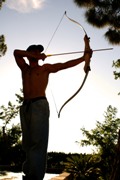Welcome to bow hunting Guide
Bow Hunting Elk Part 1 Article

Bow Hunting Elk: Big Game; Big Hunt
from:The first step to bow hunting elk is getting the just right bow hunting gear, from your bow all the way to things as simple as bow string or braces. Once you have gotten the proper equipment, the next step is knowing your game. Whether you are a beginning bow hunter or experienced, if you are bow hunting elk for the first time, you really are going to need to become very familiar with the elk themselves.
Elk feed primarily in meadows on wildflowers and seeds. They prefer areas with at least 25% cover, and love mountain top meadows for their feeding ground. Elk prefer slopes of 15-30%, so look for this type land to bow hunt elk. In summer and winter too, elk prefer upper, rather than lower or middle slopes. Slopes facing south are preferred in winter and in summer Northeast slopes are best, because they retain more moisture.
Evergreen wooded areas provide bedding for elk, because they give good cover, keep out wind, rain, and shade in the summer. If you are bow hunting elk, these are all good places to find them, especially if the area is 75 to 100% closed, with the exception of warm weather night time beds which are often in open areas.
Some great tips experienced hunters recommend for bow hunting elk are:
• Go for a lung shot. When you see pink, frothy bubbles coming from the bull's side, you know you have a lung shot. If you manage to hit both lungs, you will bring your bull down quickly.
• Wind direction: Glue some thread to a feather and use electrical tape to attach it to your bow. That way, you can easily see the wind direction, no matter how still the day. If you do this, you will not have to reveal your movement by throwing dirt into the air.
• Bugle after an arrow is shot at a bull. If you do, the bull is likely to turn and come back to you. This is a good practice, because it can save a grueling tracking job.
• Use your partner when bow hunting elk to do the calling while he stays behind and you get about half way between the caller and the bull. Practice hand signals, so that whenever one of you sees the bull, you can let the other know in case his view is blocked.









